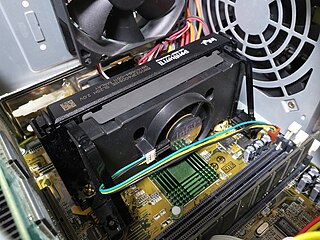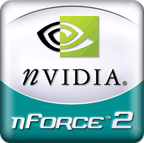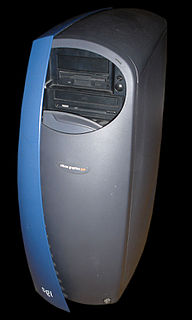Rambus DRAM (RDRAM), and its successors Concurrent Rambus DRAM (CRDRAM) and Direct Rambus DRAM (DRDRAM), are types of synchronous dynamic random-access memory (SDRAM) developed by Rambus from the 1990s through to the early-2000s. The third-generation of Rambus DRAM, DRDRAM was replaced by XDR DRAM. Rambus DRAM was developed for high-bandwidth applications, and was positioned by Rambus as replacement for various types of contemporary memories, such as SDRAM.

Pentium 4 is a series of single-core CPUs for desktops, laptops and entry-level servers manufactured by Intel. The processors were shipped from November 20, 2000 until August 8, 2008. The production of Netburst processors was active from 2000 until May 21, 2010.

The Pentium II brand refers to Intel's sixth-generation microarchitecture ("P6") and x86-compatible microprocessors introduced on May 7, 1997. Containing 7.5 million transistors, the Pentium II featured an improved version of the first P6-generation core of the Pentium Pro, which contained 5.5 million transistors. However, its L2 cache subsystem was a downgrade when compared to the Pentium Pros.

The Pentium III brand refers to Intel's 32-bit x86 desktop and mobile microprocessors based on the sixth-generation P6 microarchitecture introduced on February 26, 1999. The brand's initial processors were very similar to the earlier Pentium II-branded microprocessors. The most notable differences were the addition of the Streaming SIMD Extensions (SSE) instruction set, and the introduction of a controversial serial number embedded in the chip during manufacturing.

A front-side bus (FSB) is a computer communication interface (bus) that was often used in Intel-chip-based computers during the 1990s and 2000s. The EV6 bus served the same function for competing AMD CPUs. Both typically carry data between the central processing unit (CPU) and a memory controller hub, known as the northbridge.

VIA Technologies Inc., is a Taiwanese manufacturer of integrated circuits, mainly motherboard chipsets, CPUs, and memory. It was the world's largest independent manufacturer of motherboard chipsets. As a fabless semiconductor company, VIA conducts research and development of its chipsets in-house, then subcontracts the actual (silicon) manufacturing to third-party merchant foundries, such as TSMC.

Xeon is a brand of x86 microprocessors designed, manufactured, and marketed by Intel, targeted at the non-consumer workstation, server, and embedded system markets. It was introduced in June 1998. Xeon processors are based on the same architecture as regular desktop-grade CPUs, but have advanced features such as support for ECC memory, higher core counts, more PCI Express lanes, support for larger amounts of RAM, larger cache memory and extra provision for enterprise-grade reliability, availability and serviceability (RAS) features responsible for handling hardware exceptions through the Machine Check Architecture. They are often capable of safely continuing execution where a normal processor cannot due to these extra RAS features, depending on the type and severity of the machine-check exception (MCE). Some also support multi-socket systems with two, four, or eight sockets through use of the Quick Path Interconnect (QPI) bus.

Slot 1 refers to the physical and electrical specification for the connector used by some of Intel's microprocessors, including the Pentium Pro, Celeron, Pentium II and the Pentium III. Both single and dual processor configurations were implemented.

In computing, a northbridge, is one of two chips comprising the core logic chipset architecture on a PC motherboard. A northbridge is connected directly to a CPU via the front-side bus (FSB) to handle high-performance tasks, and is usually used in conjunction with a slower southbridge to manage communication between the CPU and other parts of the motherboard. Since the 2010s, die shrink and improved transistor density have allowed for increasing chipset integration, and the functions performed by northbridges are now often incorporated into other components. As of 2019, Intel and AMD had both released chipsets in which all northbridge functions had been integrated into the CPU. Modern Intel Core processors have the northbridge integrated on the CPU die, where it is known as the uncore or system agent.

The nForce2 chipset was released by Nvidia in July 2002 as a refresh to the original nForce product offering. The nForce2 chipset was a platform for motherboards supporting AMD's Socket A CPUs along with DDR SDRAM. There were variations of the chipset including one with and one without an integrated GeForce4 MX graphics processor (IGP).

Silicon Integrated Systems is a company that manufactures, among other things, motherboard chipsets. The company was founded in 1987 in Hsinchu Science Park, Taiwan.

SGI Visual Workstation is a series of workstation computers that are designed and manufactured by SGI. Unlike its other product lines, which used the 64-bit MIPS RISC architecture, the line used Intel Pentium II and III processors and shipped with Windows NT 4.0 or Windows 2000 as its operating system in lieu of IRIX. However, the Visual Workstation 320 and 540 models deviated from the architecture of IBM-compatible PCs by using SGI's ARCS firmware instead of a traditional BIOS, internal components adapted from its MIPS-based products, and other proprietary components that made them incompatible with internal hardware designed for standard PCs and hence unable to run other versions of Microsoft Windows, especially Windows 9x. By contrast, the remaining models in the line are standard PCs, using VIA Technologies chipsets, Nvidia video cards, and standard components.

The Intel 440BX is a chipset from Intel, supporting Pentium II, Pentium III, and Celeron processors. It is also known as the i440BX and was released in April 1998. The official part number is 82443BX.

The Intel i810 chipset was released by Intel in early 1999 with the code-name "Whitney" as a platform for the P6-based Socket 370 CPU series, including the Pentium III and Celeron processors. Some motherboard designs include Slot 1 for older Intel CPUs or a combination of both Socket 370 and Slot 1. It targeted the low-cost segment of the market, offering a robust platform for uniprocessor budget systems with integrated graphics. The 810 was Intel's first chipset design to incorporate a hub architecture which was claimed to have better I/O throughput and an integrated GPU, derived from the Intel740.
The P35 Express is a mainstream desktop computer chipset from Intel released in June 2007, although motherboards featuring the chipset were available a month earlier. The P35 Express chipset supports Intel's LGA 775 socket and Core 2 Duo and Quad processors, and is also known to support 45 nm Wolfdale/Yorkfield dual and quad core CPUs. Theoretically, Intel also dropped support for Intel's Pentium 4 and Pentium D processors with this chipset although late Pentium 4 processors, including both the 32-bit-only (5x0) and the 32-bit/64-bit (5x1), and a few others, were fully supported.
Apollo VP3 is a x86 based Socket 7 chipset which was manufactured by VIA Technologies and was launched in 1997. On its time Apollo VP3 was a high performance, cost effective, and energy efficient chipset. It offered AGP support for Socket 7 processors which was not supported at that moment by Intel, SiS and ALi chipsets. In November 1997 FIC released motherboard PA-2012, which uses Apollo VP3 and has AGP bus. This was the first Socket 7 motherboard supporting AGP.













